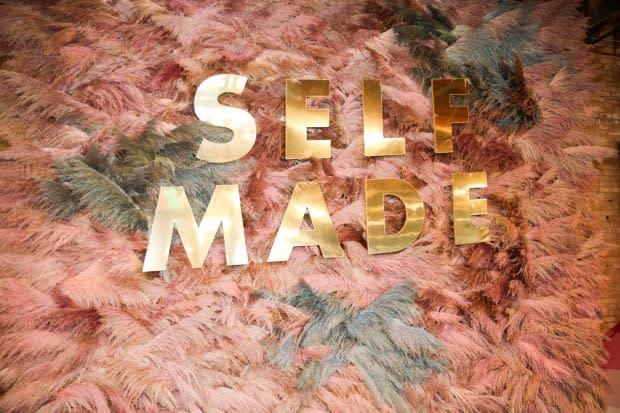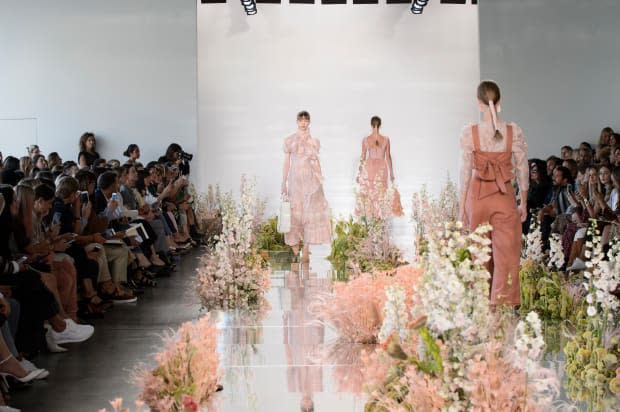Fashion's Fluffy Flower Obsession, Explained
First came the roses. Then, the peonies. Now, the industry can't get enough of "fluffies."

"Pink pampas pays the bills."
It's a running joke at East Olivia, a New York-based creative agency headed up by Kelsea Olivia, that specializes in dreaming up those colossal, large-scale floral installations you've seen on Instagram. Its first of these — an incredibly photogenic wall featuring 1,2000 pampas grass stems that had each been hand-dyed pink (pictured above) — was set up in 2018 and took more than 60 hours to create.
"At least 25 to 30% of our clients request pampas grass in some form or another, even if it isn't the focal point of their installation or arrangements," Olivia says. "We end up probably using it in about 50 to 75% of our work."
East Olivia's pampas grass designs, dyed and otherwise, have been commissioned for clients like Nordstrom, Anthropologie, TVF for DVF, Mara Hoffman and, amazingly, Jennifer Lopez. But the grassy stem can be spotted all across the industry: Ulla Johnson has lined her runways with it; Susan Korn, founder of the whimsical beaded accessories brand Susan Alexandra, decorated her last sample sale with it; when Emily Ratajkowski launched earrings for her brand Inamorata, she used fiery red pampas grass as a backdrop.
Don't know what pampas grass is? You most certainly, quite definitively know what it looks like: a tall stem that's topped by a fluffy, feathery head in the shape of a plume. And when clumped together, it resembles something like a sheaf of wheat.

Pampas grass — species name: cortaderia selloana — is native to South America. It can grow up to 12 feet tall. It thrives in the summer. It's considered a weed to farmers (and it's even banned in places like New Zealand and Hawai'i.) And it's wildly popular on Instagram.
Olivia discovered it four years ago — before East Olivia was born — when she was an engagement manager at Anthropologie, sourcing various grasses for a seasonal floor reset. But some florists say the popularity of pampas grass began growing two years ago, thanks to wedding and home décor images on Instagram. You might recognize the shot: slightly off-center, taken to capture an inspirational hyper-minimalist environment, with a single stem (sometimes two or three) blooming from a vase, apologetically dramatic, eye-catching without being overtly so.
"It wasn't so much me seeking out pampas grass, but more people sending me images on Instagram, asking me, 'Where can I get this fluffy stuff?,'" says Ryan Norville, florist and creative director of Oat Cinnamon. "The demand was so rampant."
“The look of it is soft, cozy, homey, and it's big — anything that's big and unexpected is going to get more attention," Norville continues. "When I started finding them in colors, people just freaked out. I feed off what people are excited about, so I started to find ways to get creative with it."
That creativity was on full display at the Susan Alexandra sample sale, where she was invited to sell her florals. (Korn is a friend of Norville’s.)
"Pampas grass is this beautiful, long-lasting flower, and I absolutely think that's why it's so popular," Korn says. "I'm looking at the ones in my studio, which have been there since the sale in November, and they look amazing. They're pretty, elegant and easy. What's funny is that they’re the only thing in the whole studio that's not colorful, so it pops more because they're such a neutral. They're leaning against watermelon bags right now."
Kelsie Hayes, florist and founder of Popup Florist, believes longevity is one of the reasons why both pampas grass and dried flowers are a huge hit right now. And she says people can't get enough: When she launched her second storefront at Neiman Marcus in New York’s Hudson Yards (her first location is in the East Village), she had a flower cart where one side featured fresh blooms, the other dried — and "no one was buying fresh flowers," she recalls, almost incredulously. "Everybody wanted dried flowers."
"Pampas grass and dried flowers are low-maintenance, long-lasting, and they've taken on a whole new meaning — they're not the same dried flowers you'll find at your grandma's house," Hayes says. (Her tips to preserve them: Avoid direct sunlight, put them in one place and don't touch them. To prevent pampas grass from shedding, spritz hairspray.)
When Hayes launched Popup Florist in 2016, she says 20% of her online orders were for dried flower bouquets — now, they're up to 50%. On the events side, she adds, 60% of her clients request dried flowers. "It's pampas grass, but I also think dried flowers as a whole are a big trend right now," she says. "I think it's here to stay for a while."
Another attractive thing about pampas grass — along with its aesthetic and longevity — is its sustainability story. Though it's considered a weed in some places, it's desired in others, so much so that pampas grass stems can be found year-round now despite only being in season in the summer and early fall. Plus, pampas grass can be reused multiple times over.
"Since pampas dries out so well, we typically rent the stems to our clients," Olivia says. "This way we can reuse and repurpose them over and over again, lessening our environmental footprint and contribution to waste created by our industry."
Pampas grass-infused installations can be taken apart and given away for a chance at a second life — unlike fresh flowers, which, Norville says, won't last much longer after an event. "It slows down the process of just how much flowers are being consumed and wasted," she adds.
And because fashion month, the biggest event in the industry, is just a month away, it's hard not to see pampas grass making an appearance. Korn remains tight-lipped about her Feb. 8 presentation, but she hints: "Who knows? Pampas grass might make its way in. I'm not saying that to be coy, but it's because I'm not sure. It very well could be — I love the drama, and I like the idea that people can take a little bit of the installation to go."
Olivia believes the fashion industry is drawn to pampas grass because it adds texture in bouquets — it sparks intrigue, it softens sharper edges of traditional flowers and it packs drama. And with the right treatment, whether it's dried or dyed, its effect can be manipulated to align with any designer's aesthetic, from bohemian-leaning to pretty-with-an-edge.
Regardless of how it's used or presented, the consensus is that pampas grass and its other fluffy associates, like bunny tails (they look just like how they sound), is that they impart happiness. They spark joy.
"There's something very free about them," Korn says. "When the world feels stressful, beautiful things can be very soothing. These are clouds on a stem — they're whimsical, they're pleasing to look at, and they make me feel happy."
Want more Fashionista? Sign up for our daily newsletter and get us directly in your inbox.